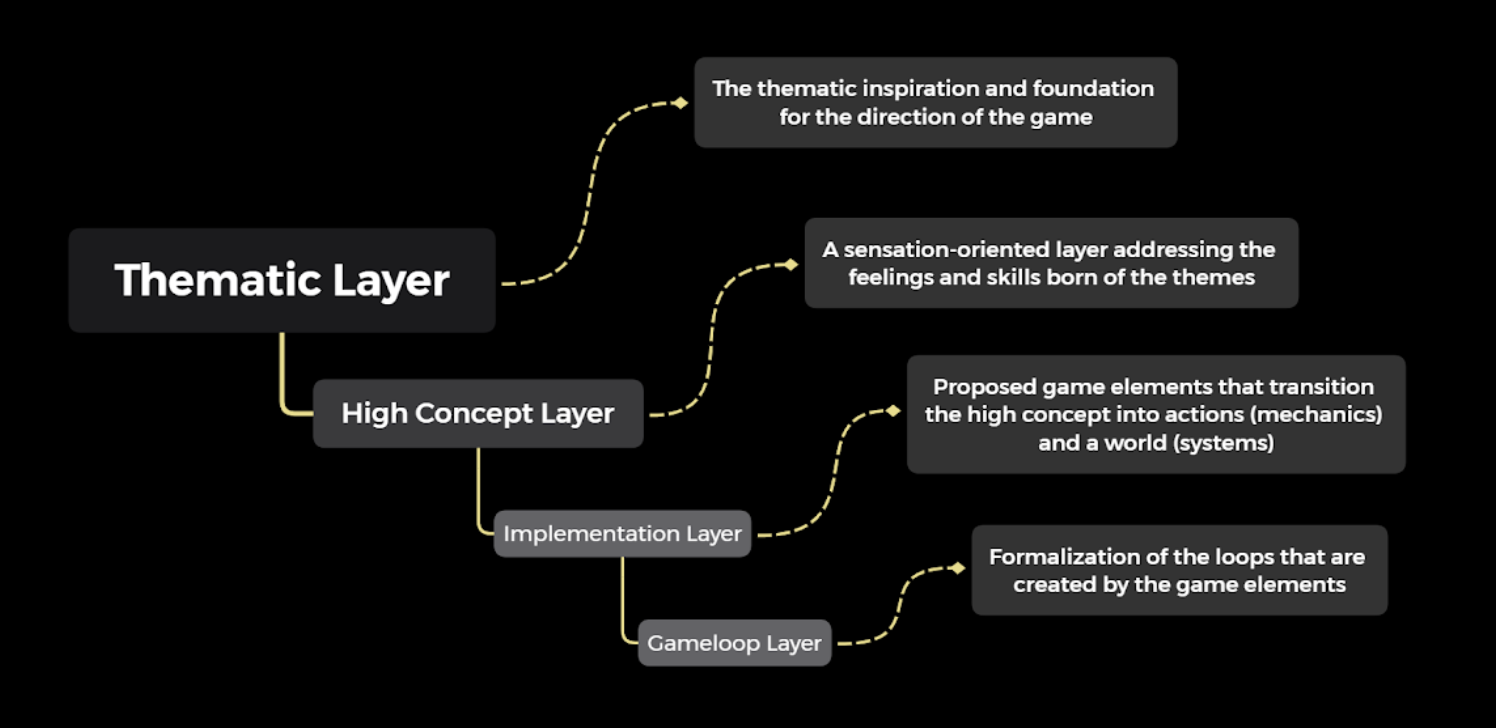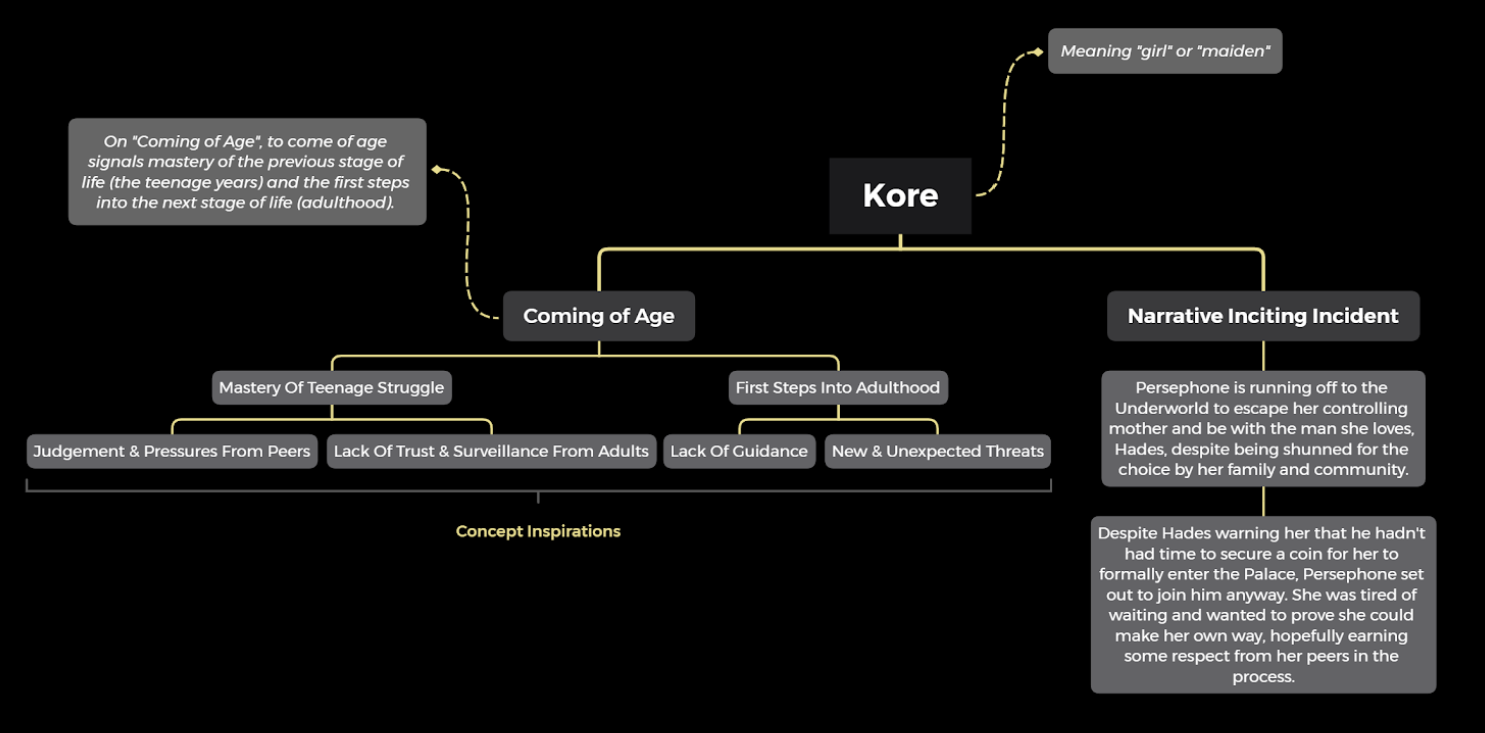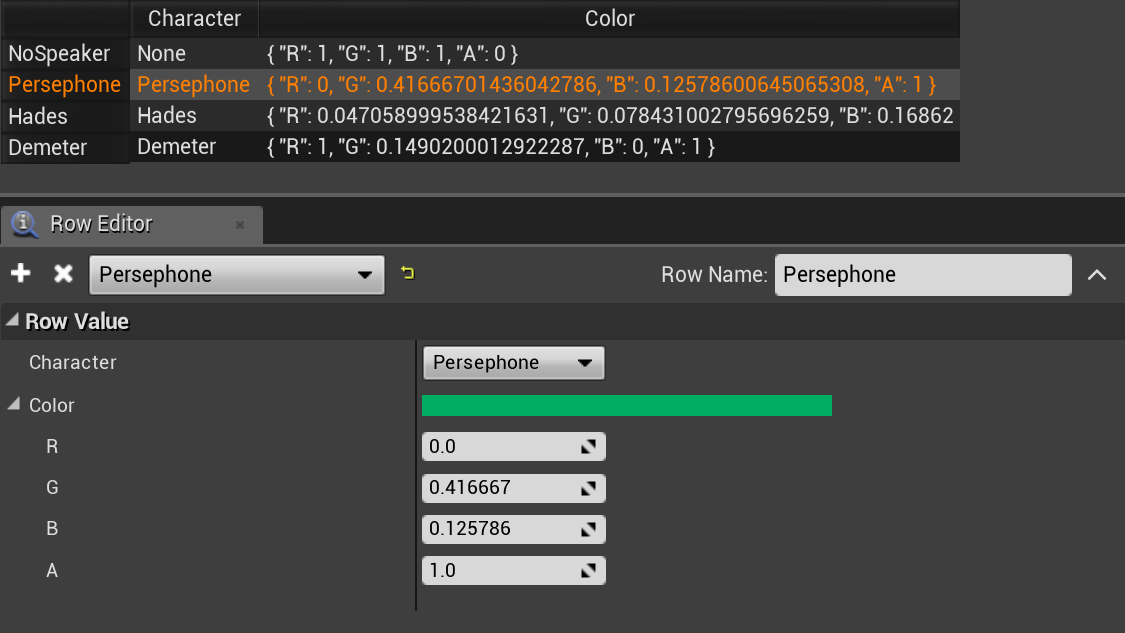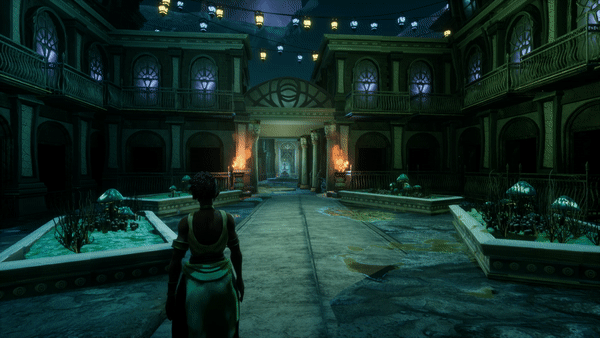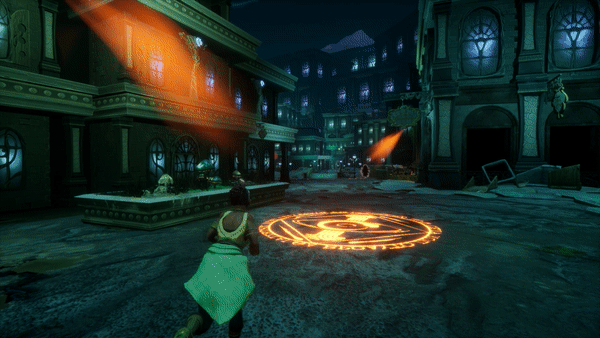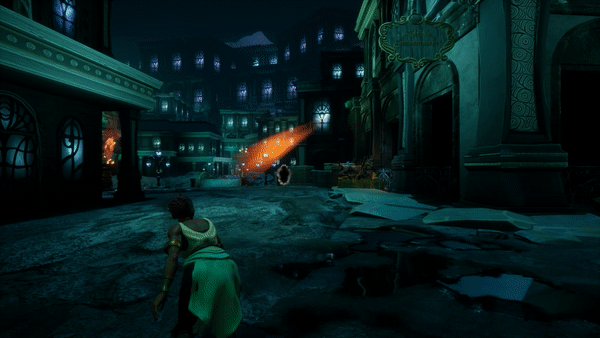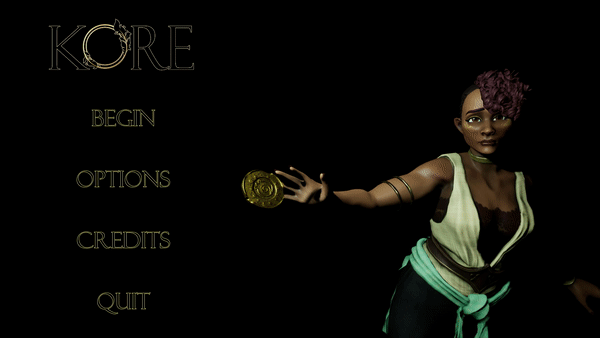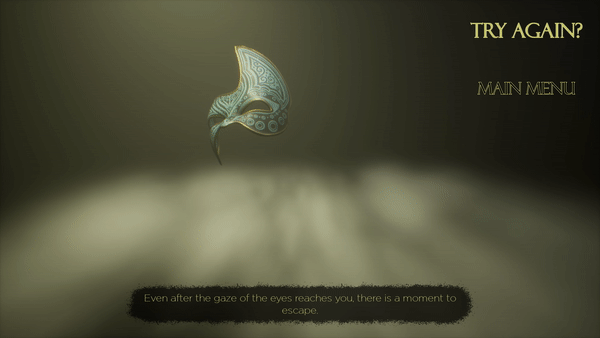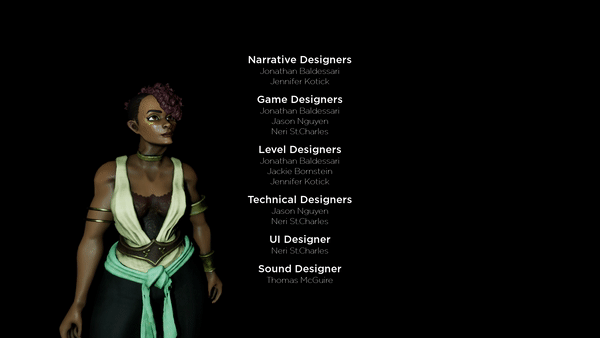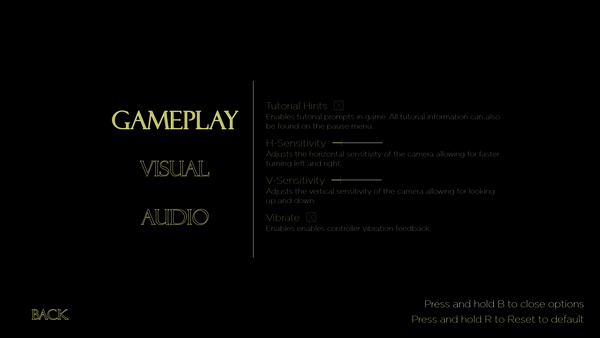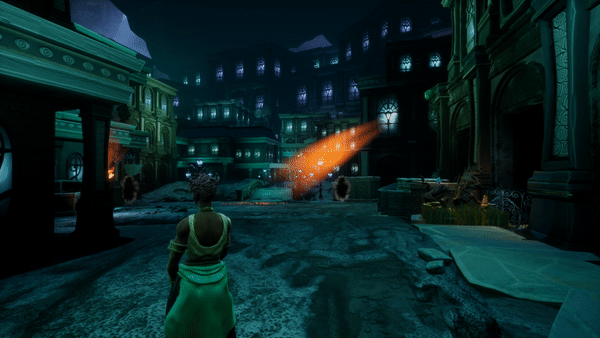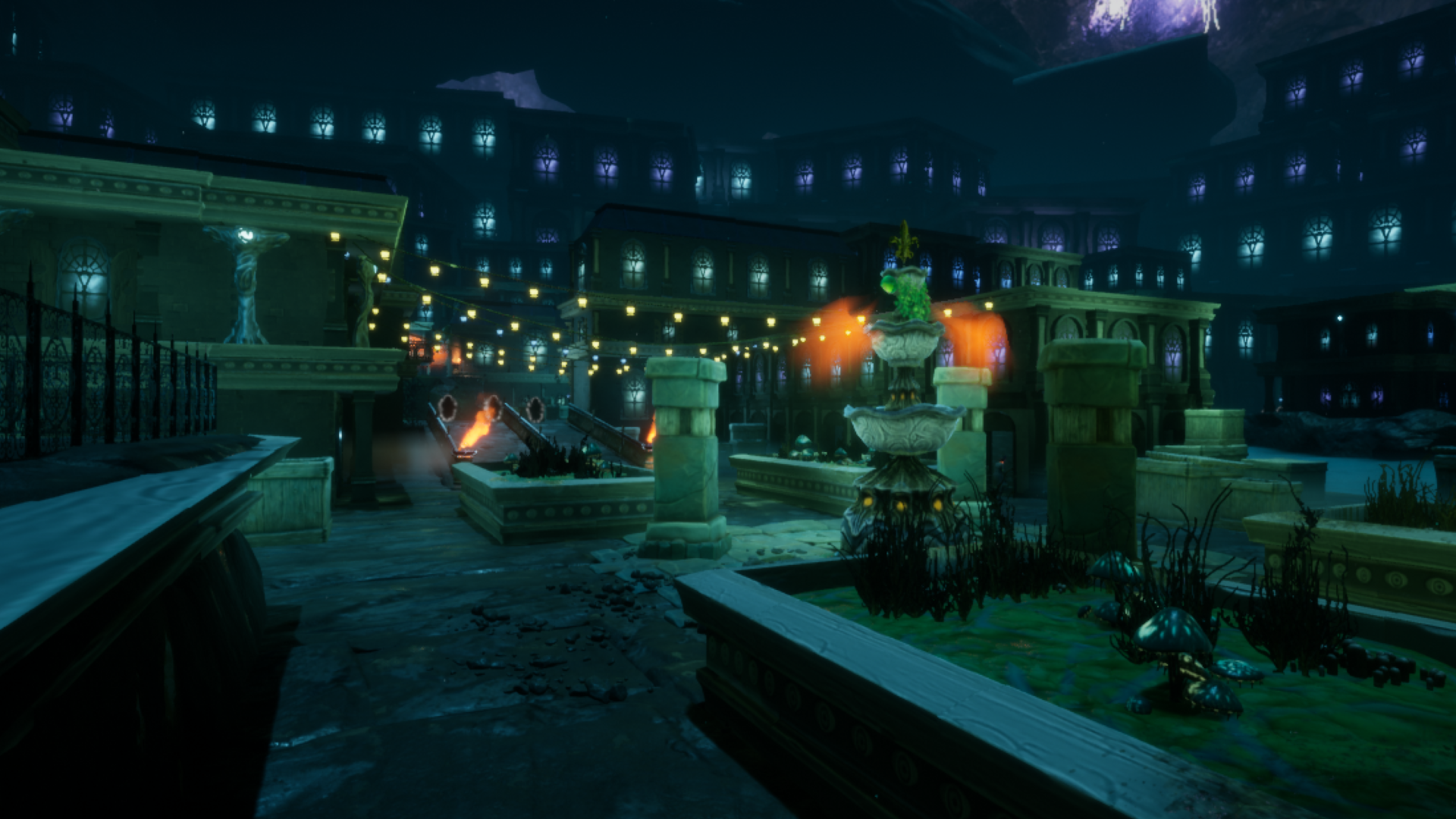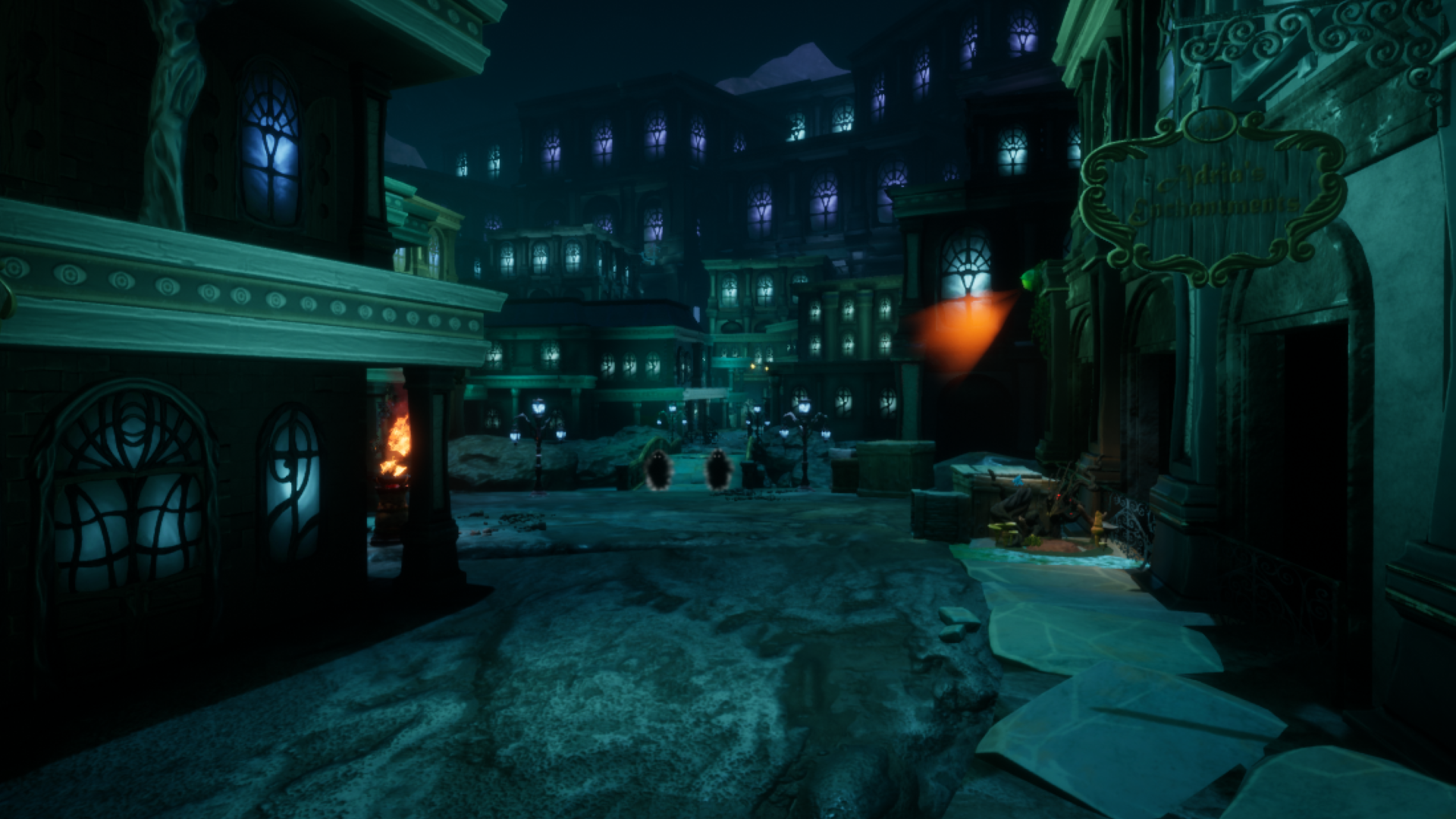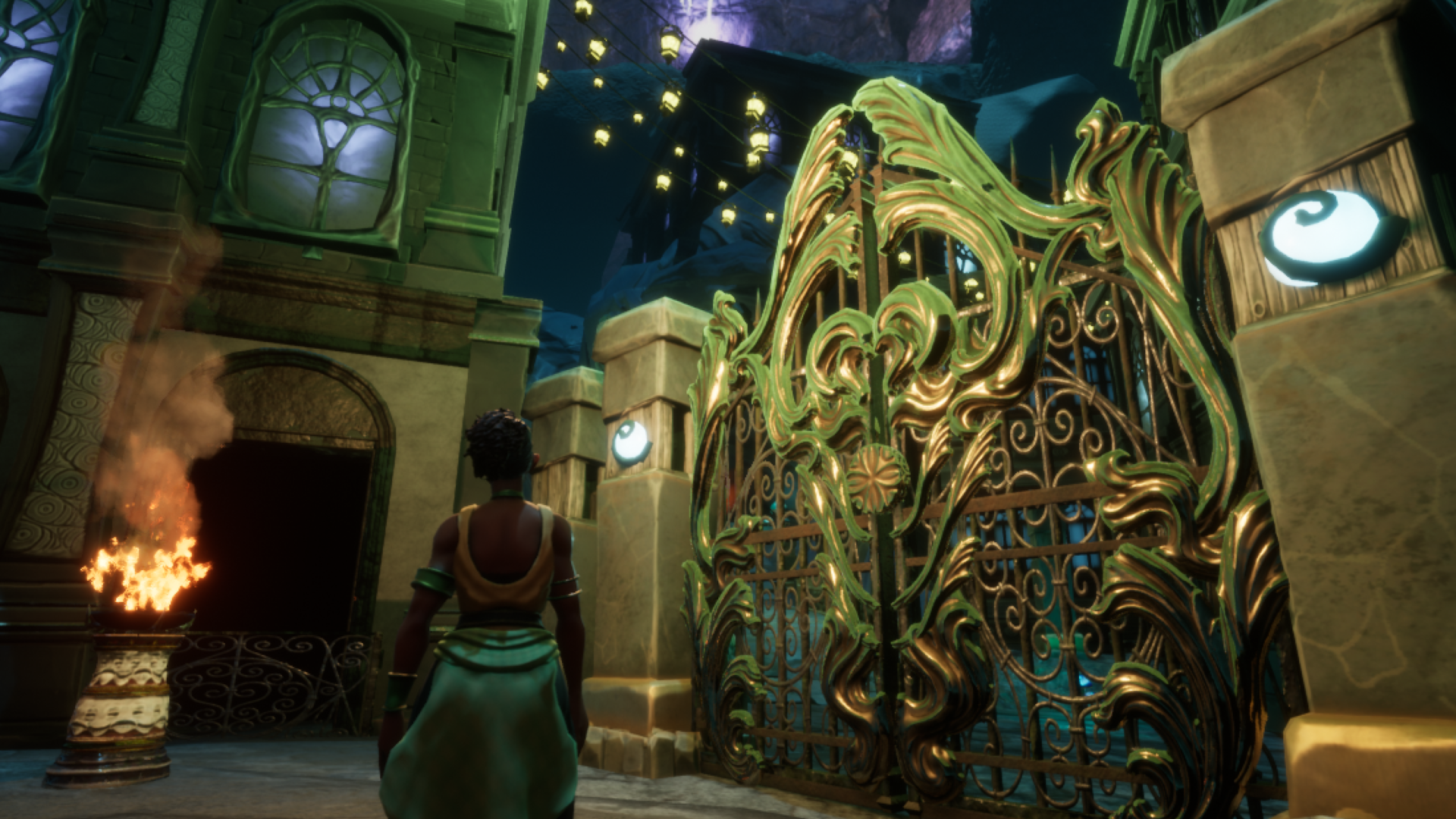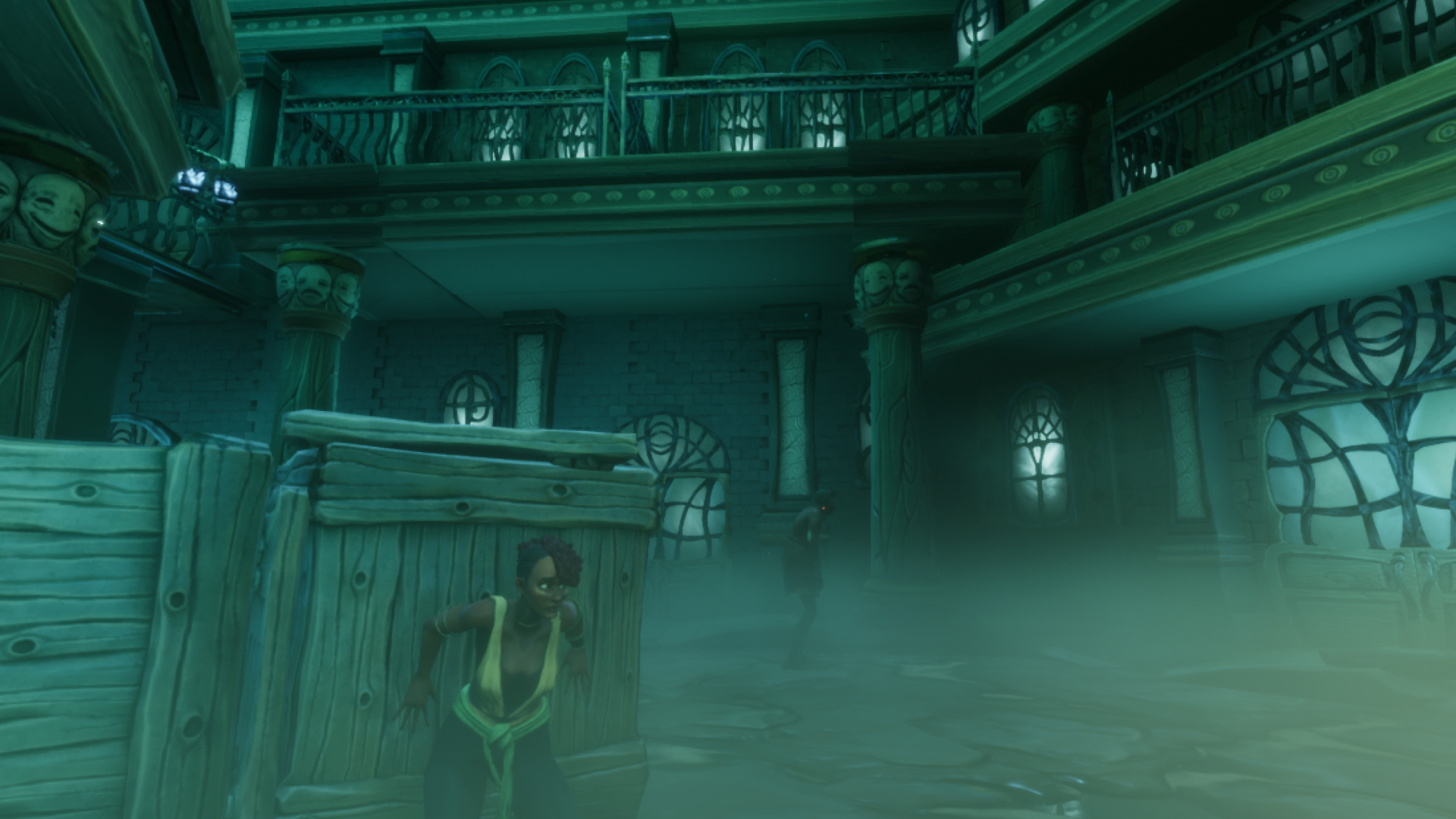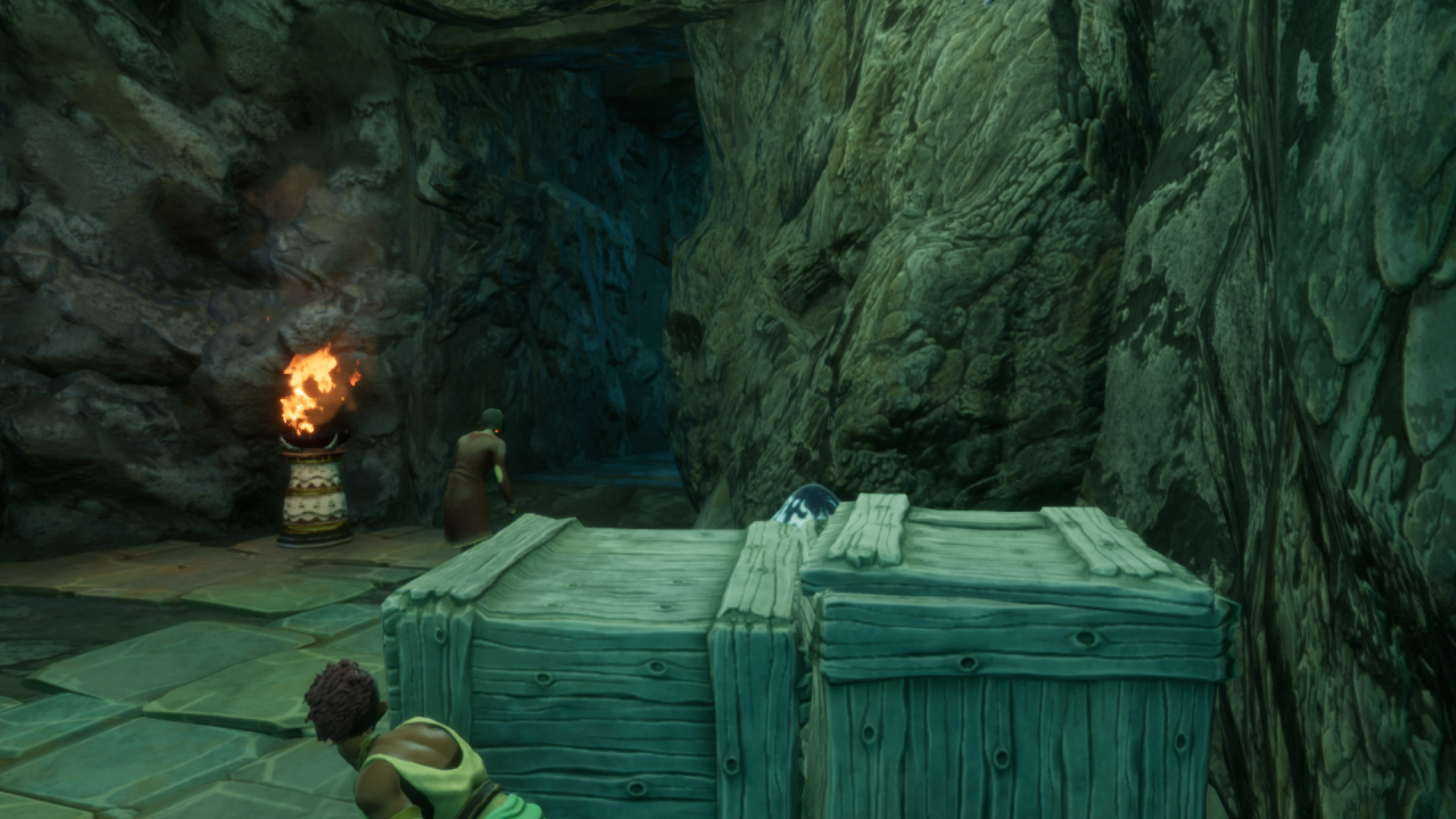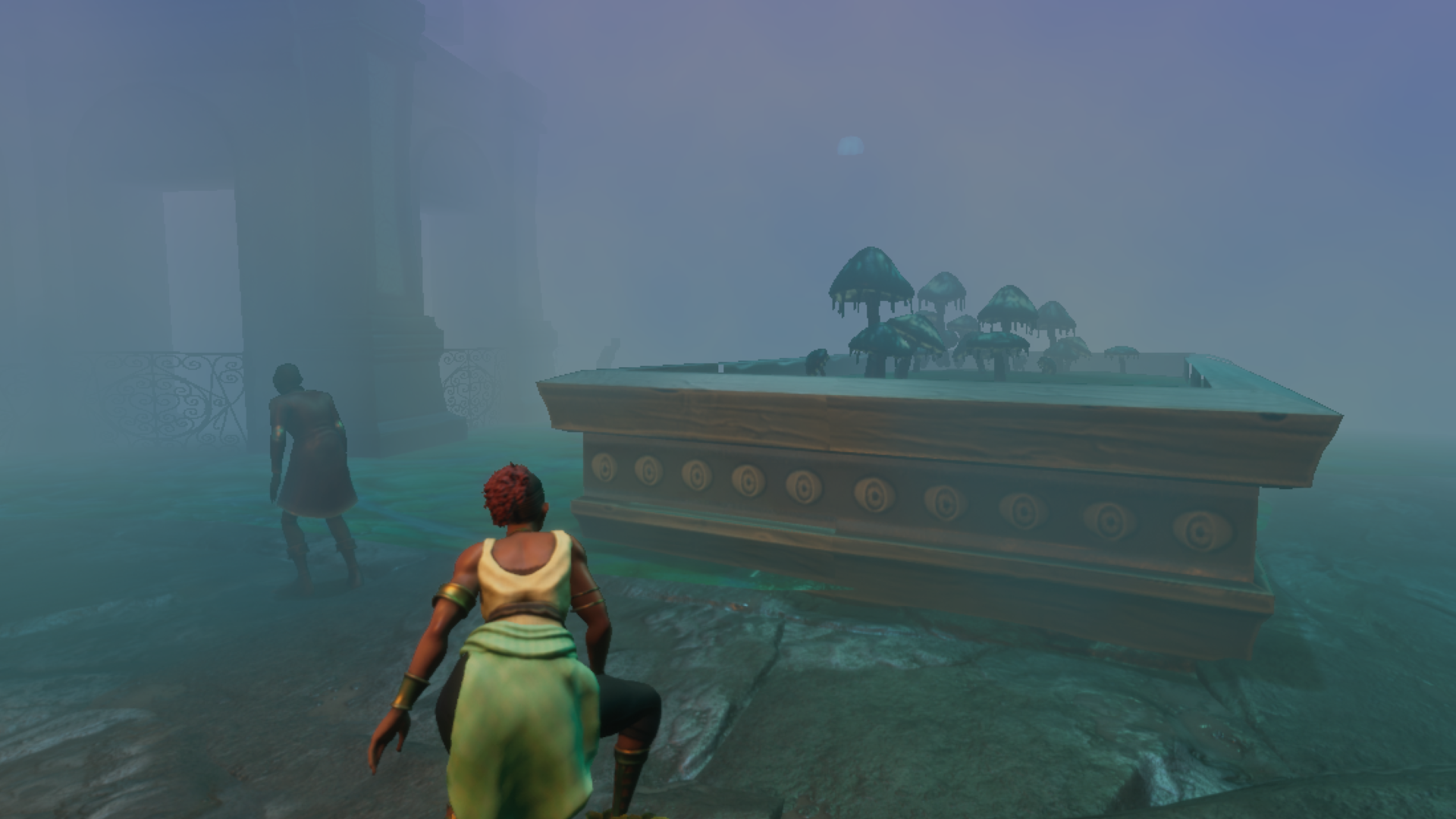Kore is a narrative focused third-person stealth game that follows a modern take on the story of Persephone and Hades where she escapes to Underworld of her own free will.
Format
Engine
Unreal Engine 4
Team Size
Fifteen Core Team + Four Assisting Members
Development Time
Eight months during school semesters.
Roles & Tasks
Game Designer
Stealth Game Verb Analysis
Exploratory System & Mechanic Design
Core Game Redesign
Technical Designer
Power System
Throw & Throwable System
Exploratory System & Mechanic Prototypes
Narrative Delivery System
Respawn System
Camera Distance Fade Effect
Foot IK Implementation
Gamestate & Level Load System
Steam Integration
Broad Technical Mentorship & Bugfixes
UI Designer
Menu Design & Functionality
Credits Screen Design & Functionality
Subtitle System Design & Functionality
Tutorial System Design & Functionality
Miscellaneous HUD Tasks
Design Goals
Create a short (roughly 10-20 minute) game that supports a coming of age story featuring a quest to escape an overbearing mother and find confidence
Keep scope manageable for a small team exiting pre-pro and entering full production with only three months left
Create a modern and thematically integrated UI
Technical Goals
Create a strong framework for pre-pro development to accommodate rapid prototyping
Create a narrative delivery system and accompanying subtitle system that allows for rapid implementation, accurate delivery, and easy iteration
Polish the game as needed in preparation for release
Core Game Design Discussion
By the time I was tasked with creating the framework for the core game structure and game loop I had a few key constraints:
A loose plot structure
The stealth genre
A core character model and locomotion set
An enemy model and locomotion set
A partially developed level section
Some environment models and effects
A few key pieces of technology (namely a “camera flower”, some basic stealth AI, and a few miscellaneous tech features prototyped to differing degrees)
A timeline of three months
With that in mind I started at our thematic base and worked my way down to mechanic implementation in a sort of waterfall design methodology.
Following this thematic path led to a game about sneaking past surveillance and shady figures, taking control of circumstance, and pushing out into the world even in unsure conditions.
The goal was to maximize the the value of core stealth locomotion and use the systems surrounding it to create interest and tension at key points while still allowing for breathing room with narrative delivery.
Ultimately the “camera flower” was repurposed into the Eyes of Demeter and shifted to become central to progression through the world. Several of the partially prototyped mechanics and miscellaneous art assets were folded into other systems and mechanics like the bog and what would ultimately become the Watchers.
Narrative System Discussion
With a narrative heavy game being developed on a time crunch, creating a narrative system that accommodated rapid implementation and all potential changes was key. Going into its development I knew we would definitely be having voice overs, we wanted to periodically stop the player, we’d have at least three key speakers popping in and out, and we were open to the possibility of cutscenes. Two things I also added onto that list were the ability to skip narrative events (along with when they start being skippable) and an accessibility compliant subtitle system.
Finding a balance between full featured results and quick setup was tough but ultimately I settled on a system that integrates with the FMOD integration in the project and allows for some robust tweaking. The accompanying subtitles are automatically colored and tagged with their speaker at the start of a new line and are chopped into sublines to be more digestible based on pre-determined markers in their text field which line up to markers in their FMOD file. All important parameters for the system are stored in data tables and loaded into the manager to allow for easy designer tweaking and to avoid checkout conflicts with technical assets or levels.
Tutorial System Discussion
In a game with a few atypical systems and very little in-world training time relative to total experience length and world space, having thorough text tutorials seemed critical. Throwing big text walls at the player wasn’t particularly desirable either but was potentially inevitable.
Through some iteration I settled on stopping player movement while keeping the world alive. I also ended up popping a short looping video pertaining to the action into the window to create some visual interest rather than just blocking without some sort of “reward”. To make sure tutorials were accessible for different reading speeds and needs the tutorials stay up until the player dismisses them with a button press but to ensure understanding I also created variants that require a specific action (like moving, sprinting, or crouching) that are also automatically skipped if they’re performed before the prompt would be delivered. To avoid accidental dismissals there’s an adjustable window when they first appearing during which they can’t be immediately dismissed which also encourages players to try reading them. Finally, I store all of the tutorials in a menu that can be accessed and flipped through from the pause menu in case anything needs to be referenced later.
Broad UI Design Discussion
As far as UI I wanted to push some of the small details to make sure things were as responsive and intuitive as I could manage and also to integrate the UI into the mood and aesthetic of the game.
As far as integration, I made an effort to keep our protagonist front and center as often as possible as we were telling an intensely personal story and she was a hero asset. I used a font in line with our title font for key headings and a clean thin font for text bodies to keep things as readable as possible. There’s a lot of black space in the menus deliberately to allow for that intimacy and focus while minimizing the number of boxes that need to be displayed which often create a more cluttered aesthetic.
To create the responsive UI I was hoping for I made sure to take advantage of a combination of highlights and scaling for selection and multiple input methods for most key actions (back buttons in a addition to button press options). A few other small details I managed to implement are holds for key actions (reloading from checkpoint, closing the options menu, skipping narrative events or the credits) and pop up screens for major one way trips (notably quitting the game).
Misc. Technical Discussions
I tackled various technical tasks in the project that don’t fall under the UI umbrella. Early on in development I built some of our exploratory systems like our power system (a framework that unified different powers behind a centralized system that could trigger them several different ways) and our throwables system (similar to the power system but with projectiles and impact behaviors) both of which were documented for team use. Later on I was also able to develop a lot of the core progression material like the narrative system and gamestate updates. I think the former set helped keep the game unified during a rapid expansion/prototyping stage and the latter gave us structure to feed key functionality through.
Throwables & power system integrated, using the throwables system to toss a “camera eye” and the power system to activate it.
In the polishing phase of the game’s development I also had the opportunity to tackle some miscellaneous features:
Adding some more life to our Eyes of Demeter using sway
Make the Eyes of Demeter easier to work with in development by modifying some construct scripts
Make our Watcher detection effect more immersive by experimenting with the material graph to get a softer edge
Making our Watcher’s more responsive by modifying their particles when they’re being burned away
Adding Steam support / achievements
Creating a shippable dev key system
Fixing bugs across the project both in my older codebase and others’
Watcher effect with directionality and soft edges which then fades out on death.
STORIES
Early on in the exploratory phase of our development I decided to do a verb analysis of stealth games as a whole and, later on, an analysis of stealth-horror games. I found that tackling research this way helped to avoid the pitfall that research can turn into where you end up caught up copying the mechanics and systems of peers. Instead I was able to cut straight to the heart of what the fantasies and expected actions of the genres were and get some inspiration on a more abstract level for what sorts of things we might do. Ultimately the game ended up with a fairly paired down systemic and mechanical framework but I do think it helped to shape what options I knew I had for developing it.
With this project I wasn’t able to secure a lead position which put me in a new scenario. I was able to see what sorts of expectations and power dynamics exist on the other side of the leads table and get a better picture of how I like to be led and how leads impact the team itself. I was also fortunate to have a lot of experience both making games and in leadership relative to my leads so I was able to assist quite a few times in different capacities. I created a tech-backlog early on for things we should expect to need to build, I helped to lead some of the design discussions, I offered some technical mentorship to the tech team, and I was able to advise our project lead on some strategic options on several occasions. Ultimately I was also brought in to tackle to redesign of the core game loop which changed the course of the project and I’d like to think I had a positive influence overall. Whether I’m in leadership or not going forward I think I’ll have a better idea of what needs to get done across the project.
Given that one of the main goals for the project was releasing on Steam, I was glad to be able to tackle much of the process to get it there. While getting it on Steam is largely covered in the last technical section, I also was responsible for handling the post-launch updates. After releasing on Steam we found both minor bugs, a rare but significant progress blocking bug, and some quality of life issues that were all reported through our community forum on Steam. I got the opportunity to interact with that community while working to patch the game to make the improvements the community wanted to see. It was a pretty small scale period of “live development” but based on some of our community posts people were glad to see the communication and issues handled swiftly. Overall I think it earned us some early good will which helped our game to reach over 20k claims!

